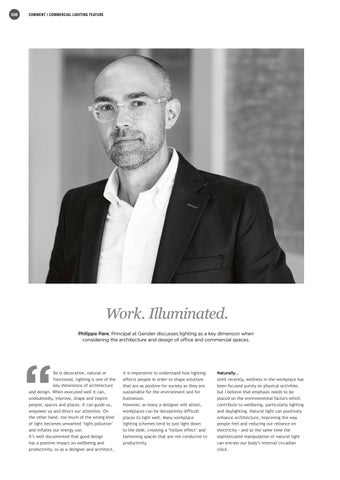098
COMMENT | COMMERCIAL LIGHTING FEATURE
Work. Illuminated. Philippe Pare, Principal at Gensler discusses lighting as a key dimenson when considering the architecture and design of office and commercial spaces.
Be it decorative, natural or functional, lighting is one of the key dimensions of architecture and design. When executed well it can, undoubtedly, improve, shape and inspire people, spaces and places. It can guide us, empower us and direct our attention. On the other hand, too much of the wrong kind of light becomes unwanted ‘light pollution’ and inflates our energy use. It’s well documented that good design has a positive impact on wellbeing and productivity, so as a designer and architect,
it is imperative to understand how lighting affects people in order to shape solutions that are as positive for society as they are sustainable for the environment and for businesses. However, as many a designer will attest, workplaces can be deceptively difficult places to light well. Many workplace lighting schemes tend to just light down to the desk, creating a ‘hollow effect’ and fashioning spaces that are not conducive to productivity.
Naturally… Until recently, wellness in the workplace has been focused purely on physical activities but I believe that emphasis needs to be placed on the environmental factors which contribute to wellbeing, particularly lighting and daylighting. Natural light can positively enhance architecture, improving the way people feel and reducing our reliance on electricity – and at the same time the sophisticated manipulation of natural light can entrain our body’s internal circadian clock.
